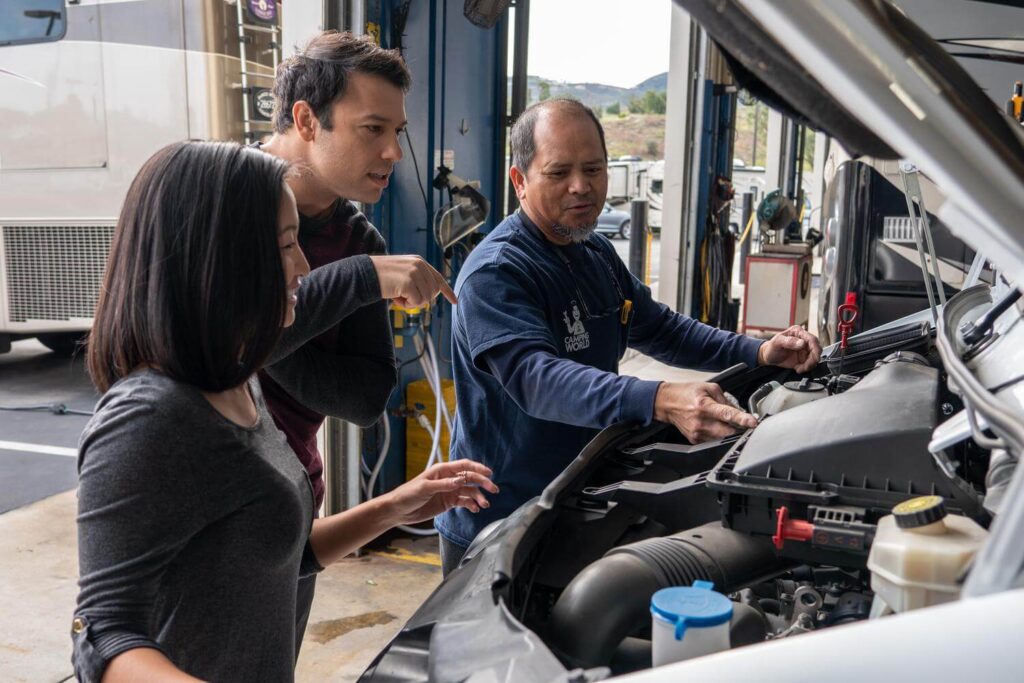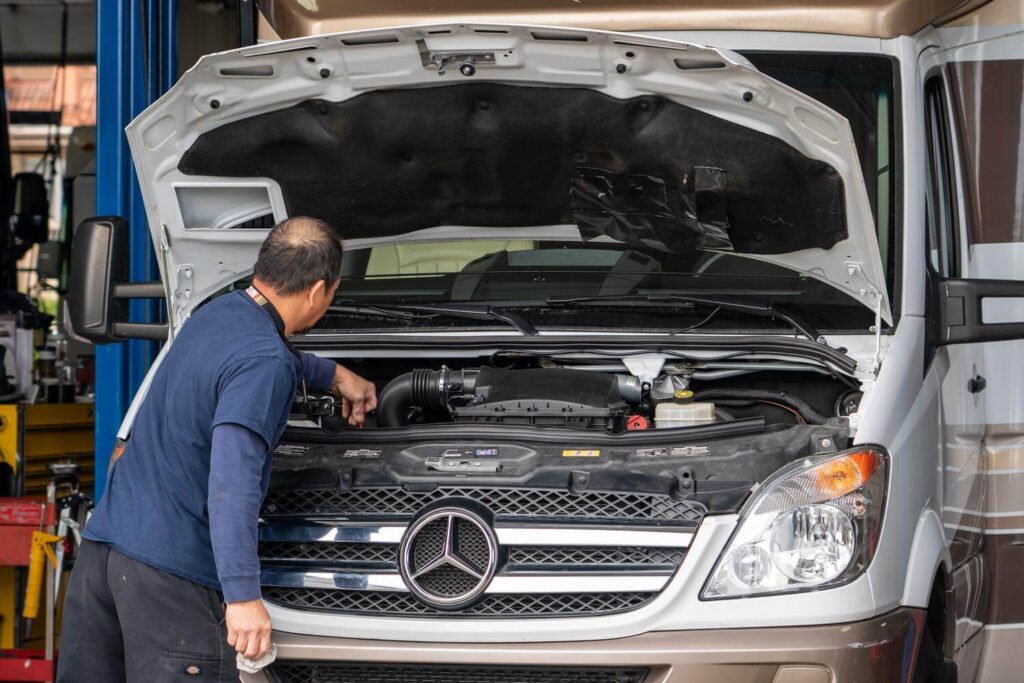An RV oil change is a great DIY maintenance task you can complete at home with the right tools, supplies, and knowledge. Of course, Camping World service centers offer oil changes on all gas and diesel motorhomes if you don’t want to get your hands dirty.
In this guide, we’ll cover recommended oil change intervals, where to find a service center near you, and the steps for completing a DIY RV oil change if you’re interested.
When Should I Get an RV Oil Change?

Photo by Camping World
Changing your RV’s engine oil regularly can reduce wear on the engine and its individual components, improve your fuel economy, increase horsepower, prevent engine overheating, and decrease the risk of breakdowns and more costly repairs. It’s important – but how often should you change your oil?
The frequency depends on factors such as fuel type, oil type, whether the unit will be moving to a seasonal location with extremely different temperatures, and miles driven per year and under what conditions.
Most motorhome manufacturers recommend changing your oil every 3,000 to 5,000 miles, or once a year for conventional oil, and 10,000 to 15,000 miles with no annual requirement for full synthetic oil.
Not all RV owners drive thousands of miles yearly, so they stick to the annual recommendation, ensuring they get an RV oil change at least once a year. Remember that most RVs sit more than they move, and this sitting is as hard, or harder, on the mechanicals than daily driving.
Some manufacturers may recommend different intervals depending on the type of oil you decide to use. Still, the manufacturer will always be your first (and best) resource for recommended oil change service intervals.
Where Can I Schedule an RV Oil Change Near Me?

Photo by Camping World
Camping World now has more than 200 locations nationwide. You’ll need to consult a service advisor at your desired location to ensure they’ll work on your RV and schedule a service if possible.
Per our RV Service Pricing List, your scheduled oil change on a gas or diesel motorhome should also include:
- Chassis lubrication
- Transmission fluid check
- Battery water level check
- Differential fluid check
- Coolant level check
- Washer fluid check and top-off
- Wiper blade inspection
At this time, you may also request a check of your RV’s engine air filter. Learn more about the importance of regularly checking and replacing your engine air filter.
How Much Does an RV Oil Change Cost at Camping World?
Prices can vary by location and service center. They will also vary depending on the type of motorhome (gas or diesel) and the amount and type of oil used to refill your RV’s oil pan. That said, here are our two RV oil change offerings:
- For Gas RVs with up to 8 quarts of engine oil – Price starts at $169.99
- For Diesel RVs with up to 20 quarts of engine oil – Price starts at $329.99
Find a Camping World RV Service Center near you.
How to Do an RV Oil Change at Home

Photo by Camping World
We’ll cover the recommended tools and supplies for those interested in performing an RV oil change at home. Then, we’ll walk you through the basic steps. Remember that your motorhome may differ slightly; the manufacturer is always your best resource for the recommended steps or any troubleshooting questions when performing this service. You’ll find their contact info in your RV’s owner’s manual or by searching online.
What You’ll Need
- Oil – the proper type (conventional, synthetic blend, or full synthetic), and the amount will be determined by your RV’s manufacturer.
- Oil filter
- Wrench with the proper-sized socket for removing the oil drain plug
- Oil filter wrench
- Oil drain container
- Work light
- Wheel chocks
- Small step ladder (the filler neck and dipstick may be very high with the RV on ramps)
- Funnel
- Shop towels
For newer motorhomes still under warranty, consult your manufacturer to see which conventional or synthetic oil they recommend. They’ll also provide the recommended amount and oil filter type, allowing you to purchase the proper supplies before getting started.
If you own an older motorhome (more than 5 years old or with greater than 50,000 miles), it’s typically best to use a full synthetic oil that’s designed for the RV’s age, mileage, and operating conditions. But it never hurts to consult your manufacturer. Camping World Specialists can also assist in finding the correct parts and fluids for a DIY RV oil change.
Technician Tip: Using products not approved by the manufacturer can create warranty issues.
Steps for Completing an RV Oil Change
With the right oil filter and type/amount of engine oil in hand, along with the proper tools and your manufacturer’s recommended steps and specifications, here’s how to complete your RV oil change:
1. Drive your front tires onto tiered ramps for easier access and chock the rear wheels for safety. Set the parking brake and place an oil drain container under the oil pan’s drain plug. The engine should be warm but not hot.
2. Open the hood and clean the oil fill cap before removing it to prevent dirt and dust from entering the engine. Then, remove the cap and set it in a safe location where it’s unlikely to fall into the engine compartment if bumped or jostled.
3. Use the proper-sized socket to remove the oil pan’s drain plug. Be careful not to lose the washer on the drain plug if so equipped. Allow the oil to drain completely into the oil drain container.
4. Use an oil filter wrench to remove the oil filter and clean the mating surface to prepare for the new oil filter. Ensure the rubber gasket is removed with the old filter.
5. Replace the drain plug and torque it to the manufacturer’s specifications.
6. Lubricate the new rubber oil filter seal with a small amount of clean oil. Then, carefully start it onto the threads and spin it down until it stops. With both hands, tighten an additional ¼-turn or to the manufacturer’s specifications. Some vertical filters must be prefilled with fresh oil prior to installation. Follow the specific instructions from your vehicle’s manufacturer.
7. Use a funnel to add the manufacturer’s recommended oil type and amount through the oil fill inlet from which you removed the cap earlier.
8. Check the oil level on the dipstick to verify you’ve added the correct amount of oil. If it reads low, add more. If it reads high, you may need to remove some.
9. Replace the oil fill cap and start your RV’s engine. Run the engine to normal operating temperature – 2-3 minutes. Check for leaks under the hood and under the engine during, not just after, the warm-up period.
10. Shut the engine off and let it stand for a minimum of 1-2 minutes. Check the oil level on the dipstick again and adjust as required.
11. Note the date and your RV’s current mileage on a sticker and place it in the upper left corner of the windshield when seated in the driver’s seat.
12. Close the hood, dispose of the used oil and oil filter according to local regulations, and rinse your oil drain container if you intend to keep it for future use. Your local automotive store will have several recommended cleaning products to help clean used engine oil from your drain container. Do not use water, and do not dispose of oil or cleaners on the ground or in your sinks.
A Note on All RV Oil Changes

Photo by Camping World
Certain motorhomes may require special tools that make a DIY oil change difficult. For example, the Mercedes engine in the Sprinter chassis has an oil filter upside down on top of the engine at the front near the radiator. It requires a special tool to remove it correctly, and using substitute tools can damage the housing or result in a failure to seat and seal the new filter fully.
The new filter comes with three new O-rings that must be replaced with the filter. These can be easy to miss in the box but are critical to a proper installation. These engines also hold a massive amount of oil compared to others of similar size – from 13 to 18 quarts. This can easily cause a huge mess if you’re not ready with the proper-sized drain container and can lead to the underfilling of the crankcase.
While an oil change may seem like an easy DIY maintenance task, failure to complete the process properly can result in engine damage. Many RV engines cost between $15,000 and $25,000, meaning you’ll have a very expensive repair on your hands if you don’t complete a DIY oil change correctly.
Notes on RV Oil Changes on Diesel Motorhomes

Photo by Camping World
Variations always exist from model to model, but diesel motorhomes have an important difference from gas models – the engine is often located in the rear of the coach, hence the term “diesel pusher.” While this isn’t the case for all diesel motorhomes, it’s a common design for the Class A category. Super C RVs, for example, include many diesels with the engine under the front hood.
But if you have a Class A diesel pusher, accessing the oil cap and oil filter will require more effort than simply opening the hood. Most of these designs have an access hatch or panel in the rear of the floorplan, sometimes under the bed or on the floor in a rear bathroom or closet.
Opening that hatch to gain access isn’t the issue. It’s the fact that it can still be quite difficult to reach the fill cap and filter locations without specialized tools. The filter(s) are also very large and require a special tool to remove. Plus, these engines hold oil in GALLONS, not QUARTS.
So, be prepared to switch buckets halfway through the draining process if attempting this as a DIY maintenance task. However, these are the reasons we highly recommend entrusting your RV’s oil change to our team of certified technicians at your local Camping World Service Center.
Proper engine maintenance is critical to your safe travels as a motorhome owner. Here are a few more resources to help you keep your motorhome in peak condition:
- What Does a Motorhome Fuel Filter Do?
- Should You Change Your Motorhome’s Engine Oil If It Hasn’t Been Driven?
What questions do you have about RV oil changes? Let us know in the comments below.
The post RV Oil Change: A Guide to When, Where, and How appeared first on Camping World Blog.
By: Tucker Ballister
Title: RV Oil Change: A Guide to When, Where, and How
Sourced From: blog.campingworld.com/learn-to-rv/rv-oil-change-a-guide-to-when-where-and-how/
Published Date: Wed, 01 Nov 2023 08:00:00 +0000
---------------------------------------------
Did you miss our previous article...
https://outdoorsnewswire.com/camping/snowbird-escapes-70-new-sun-belt-good-sam-campgrounds
 CampingSurvivalistHuntingFishingExploringHikingPrivacy PolicyTerms And Conditions
CampingSurvivalistHuntingFishingExploringHikingPrivacy PolicyTerms And Conditions
